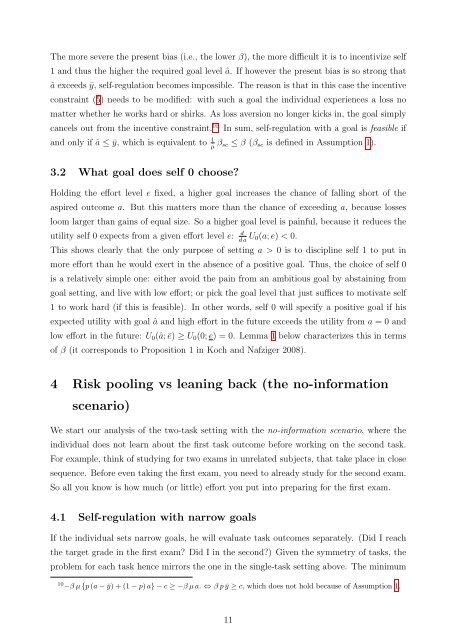Motivational Goal Bracketing - School of Economics and ...
Motivational Goal Bracketing - School of Economics and ...
Motivational Goal Bracketing - School of Economics and ...
Create successful ePaper yourself
Turn your PDF publications into a flip-book with our unique Google optimized e-Paper software.
The more severe the present bias (i.e., the lower β), the more difficult it is to incentivize self<br />
1 <strong>and</strong> thus the higher the required goal level â. If however the present bias is so strong that<br />
â exceeds ¯y, self-regulation becomes impossible. The reason is that in this case the incentive<br />
constraint (5) needs to be modified: with such a goal the individual experiences a loss no<br />
matter whether he works hard or shirks. As loss aversion no longer kicks in, the goal simply<br />
cancels out from the incentive constraint. 10 In sum, self-regulation with a goal is feasible if<br />
<strong>and</strong> only if â ≤ ¯y, which is equivalent to 1<br />
µ βsc ≤ β (βsc is defined in Assumption 1).<br />
3.2 What goal does self 0 choose?<br />
Holding the effort level e fixed, a higher goal increases the chance <strong>of</strong> falling short <strong>of</strong> the<br />
aspired outcome a. But this matters more than the chance <strong>of</strong> exceeding a, because losses<br />
loom larger than gains <strong>of</strong> equal size. So a higher goal level is painful, because it reduces the<br />
utility self 0 expects from a given effort level e: d<br />
d a U0(a; e) < 0.<br />
This shows clearly that the only purpose <strong>of</strong> setting a > 0 is to discipline self 1 to put in<br />
more effort than he would exert in the absence <strong>of</strong> a positive goal. Thus, the choice <strong>of</strong> self 0<br />
is a relatively simple one: either avoid the pain from an ambitious goal by abstaining from<br />
goal setting, <strong>and</strong> live with low effort; or pick the goal level that just suffices to motivate self<br />
1 to work hard (if this is feasible). In other words, self 0 will specify a positive goal if his<br />
expected utility with goal â <strong>and</strong> high effort in the future exceeds the utility from a = 0 <strong>and</strong><br />
low effort in the future: U0(â; ē) ≥ U0(0; e) = 0. Lemma 1 below characterizes this in terms<br />
<strong>of</strong> β (it corresponds to Proposition 1 in Koch <strong>and</strong> Nafziger 2008).<br />
4 Risk pooling vs leaning back (the no-information<br />
scenario)<br />
We start our analysis <strong>of</strong> the two-task setting with the no-information scenario, where the<br />
individual does not learn about the first task outcome before working on the second task.<br />
For example, think <strong>of</strong> studying for two exams in unrelated subjects, that take place in close<br />
sequence. Before even taking the first exam, you need to already study for the second exam.<br />
So all you know is how much (or little) effort you put into preparing for the first exam.<br />
4.1 Self-regulation with narrow goals<br />
If the individual sets narrow goals, he will evaluate task outcomes separately. (Did I reach<br />
the target grade in the first exam? Did I in the second?) Given the symmetry <strong>of</strong> tasks, the<br />
problem for each task hence mirrors the one in the single-task setting above. The minimum<br />
10 −β µ {p (a − ¯y) + (1 − p) a} − c ≥ −β µ a. ⇔ β p ¯y ≥ c, which does not hold because <strong>of</strong> Assumption 1.<br />
11
















